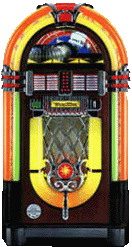 |
ARCHIVES | |
| POP SINGLES | ||
|
|
The ’40s:

The ’50s:

The ’60s:

The ’70s:

The ’80s:

The ’90s:


Also in This Archive:
• COUNTRY SINGLES
• R&B/SOUL SINGLES
• POP ALBUMS
From June 1946 through September 1961, Cash Box also published a Juke Box chart, in addition to the best-selling singles chart. This archive currently concentrates exclusively on the latter, since it was more extensive and was the forerunner of the Cash Box Top 100.
The best-seller charts originally varied in depth from 21 to 50 positions. Cash Box combined all currently available recordings of a song into one chart position, with artist and label info listed for each version, alphabetized by label, but with no indication of which version(s) were the biggest sellers. Beginning the week of August 11, 1947, the chart leveled off at 40 positions. With the issue dated October 13, 1951, the chart increased to 50 positions under the banner “The Nation’s Top 50 Best Selling Records.” At this point, the charts still did not specify which versions were the most popular. In the issue dated October 25, 1952, Cash Box began designating the hit version(s) of each song by placing a star next to the artists’ names.
In the issue dated August 4, 1956, the banner was changed to read “The Cash Box Top 50 Best Selling Tunes on Records.” The chart was expanded to 60 positions the week of April 13, 1957; to 75 positions the week of June 21, 1958; and finally to the Top 100 the week of September 13, 1958. The Cash Box Top 100 continued to be a sales-based chart until the ’70s, when airplay data began to be incorporated.
In the ’40s and early ’50s, the best-seller charts included columns showing the sales per 1000 singles sold for the current and previous weeks for each title on the chart. In 1955, that information was replaced by columns showing each title’s chart positions for the previous two weeks. It wasn’t until 1976 that Cash Box added a weeks-on-the-chart column. The format for the charts posted here is a hybrid of the mid-’60s Cash Box and Billboard charts: columns to the right of the artist’s name show the three previous weeks’ chart positions and the total weeks on the chart.
In the issue dated October 3, 1959, Cash Box introduced its Looking Ahead chart, which listed as many as 50 up-and-coming records that showed signs of breaking into the Top 100. These charts were included in the magazine up through the March 27, 1993, issue, with the exception of certain time periods, particularly the one from March 1982 through July 1990, when no Looking Ahead charts were published. A link at the bottom of each weekly chart page, beginning with the 10/3/59 chart, points to the Looking Ahead chart for that week. The posted charts include columns showing the previous week’s chart position and the total number of weeks on the Looking Ahead chart for each entry.
(Click on the links to the left to access the Country Singles, R&B Singles and Pop Albums sections of the archive.)
|
The Cash Box Pop Hits 1952-1996 and Cash Box Looking Ahead 1959-1993 chart books are available from Joel Whitburn’s Record Research. These books include thousands of song titles and hundreds of artists that do not appear in the Billboard pop chart books. For details, sample pages, and ordering information, click here. |

Play the Jukebox